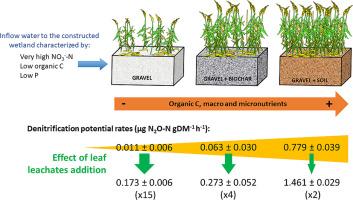叶片沥滤液的添加对地下水流构建湿地反硝化的影响取决于床基类型
IF 6.7
2区 工程技术
Q1 ENGINEERING, CHEMICAL
引用次数: 0
摘要
在人工湿地(CW)中,床基和植被的叶片沥滤液可纠正制约异养反硝化和去除农业灌溉排水中硝酸盐的低碳/氮比。然而,床基类型和叶片沥滤液对反硝化作用的交互影响仍是未知数。我们以一个化武试验工厂为重点,设计了一个实验室实验,以评估 i) 不同床层基质(石灰质砾石(传统基质)、砾石+来自天然湿地的土壤(淤泥质壤土索隆查克,有机碳含量为 1.5%)和砾石+来自热解观赏植物的生物炭(有机碳含量为 75%))的反硝化潜能率是否存在差异;以及 ii) 每种床层基质中的反硝化对添加各自的叶片沥滤液的反应。我们发现,砾石床的反硝化潜在速率(0.011 ± 0.006 μgN2O-N gDM-1 h-1)低于添加生物炭(0.06 ± 0.03),尤其是土壤(0.78 ± 0.04),而土壤是最有利的选择。此外,叶片沥滤液的添加在所有情况下都提高了反硝化率。不过,沥滤液在砾石床中的作用相对高于其他基质(分别是土壤和生物炭的 15 倍和 2 倍和 4 倍)。我们的研究结果表明,在使用砾石基质时,反硝化作用有限,这不仅是因为砾石中的碳含量低,还因为砾石中含有必需的宏量和微量元素。本文章由计算机程序翻译,如有差异,请以英文原文为准。

The effect of leaf leachates addition on denitrification in subsurface flow constructed wetlands is shaped by the bed substrate type
In constructed wetlands (CWs), bed substrate and leaf leachates from vegetation may correct the low C/N ratio that constrains heterotrophic denitrification and nitrate removal from irrigated agricultural drainage water. However, the interactive effects of bed substrate type and leaf leachates on denitrification are still unknown. By focusing on a CWs pilot plant, we designed a laboratory experiment to evaluate i) wether denitrification potential rates varied among bed substrates: calcareous gravel (a conventional substrate), gravel+soil from a natural wetland (silty loam Solonchak, 1.5 % of organic C) and gravel+biochar from pyrolyzed ornamental plants (75 % of organic C); and ii) the response of denitrification within each bed substrate to the addition of their respective leaf leachates. We found that denitrification potential rates were lower in gravel beds (0.011 ± 0.006 μgN2O-N gDM−1 h−1) than those observed with the addition of biochar (0.06 ± 0.03) and especially soil (0.78 ± 0.04), with soil being the most advantageous option. Besides, leaf leachates addition boosted denitrification rates in all cases. Nevertheless, the effect of leachates was relatively higher in gravel beds than in the other substrates (15 times higher vs. 2 and 4 times with soil and biochar, respectively). Our outcomes highlight limited denitrification when using gravel substrate not only by low C but also due to essential macro- and micro-elements, and support the role of plant leaves as internal and self-sustainable source of nutrients.
求助全文
通过发布文献求助,成功后即可免费获取论文全文。
去求助
来源期刊

Journal of water process engineering
Biochemistry, Genetics and Molecular Biology-Biotechnology
CiteScore
10.70
自引率
8.60%
发文量
846
审稿时长
24 days
期刊介绍:
The Journal of Water Process Engineering aims to publish refereed, high-quality research papers with significant novelty and impact in all areas of the engineering of water and wastewater processing . Papers on advanced and novel treatment processes and technologies are particularly welcome. The Journal considers papers in areas such as nanotechnology and biotechnology applications in water, novel oxidation and separation processes, membrane processes (except those for desalination) , catalytic processes for the removal of water contaminants, sustainable processes, water reuse and recycling, water use and wastewater minimization, integrated/hybrid technology, process modeling of water treatment and novel treatment processes. Submissions on the subject of adsorbents, including standard measurements of adsorption kinetics and equilibrium will only be considered if there is a genuine case for novelty and contribution, for example highly novel, sustainable adsorbents and their use: papers on activated carbon-type materials derived from natural matter, or surfactant-modified clays and related minerals, would not fulfil this criterion. The Journal particularly welcomes contributions involving environmentally, economically and socially sustainable technology for water treatment, including those which are energy-efficient, with minimal or no chemical consumption, and capable of water recycling and reuse that minimizes the direct disposal of wastewater to the aquatic environment. Papers that describe novel ideas for solving issues related to water quality and availability are also welcome, as are those that show the transfer of techniques from other disciplines. The Journal will consider papers dealing with processes for various water matrices including drinking water (except desalination), domestic, urban and industrial wastewaters, in addition to their residues. It is expected that the journal will be of particular relevance to chemical and process engineers working in the field. The Journal welcomes Full Text papers, Short Communications, State-of-the-Art Reviews and Letters to Editors and Case Studies
 求助内容:
求助内容: 应助结果提醒方式:
应助结果提醒方式:


